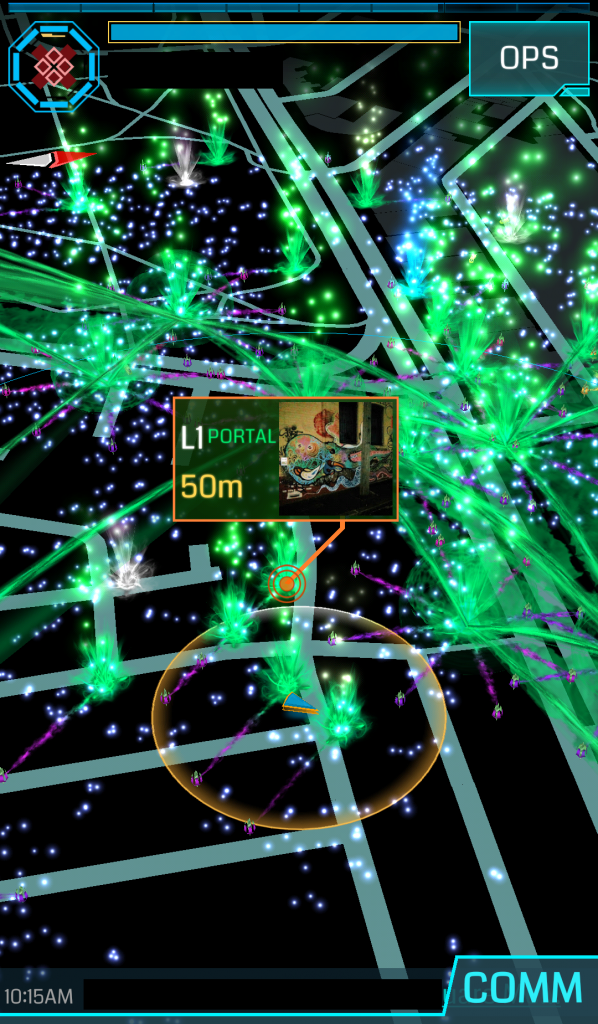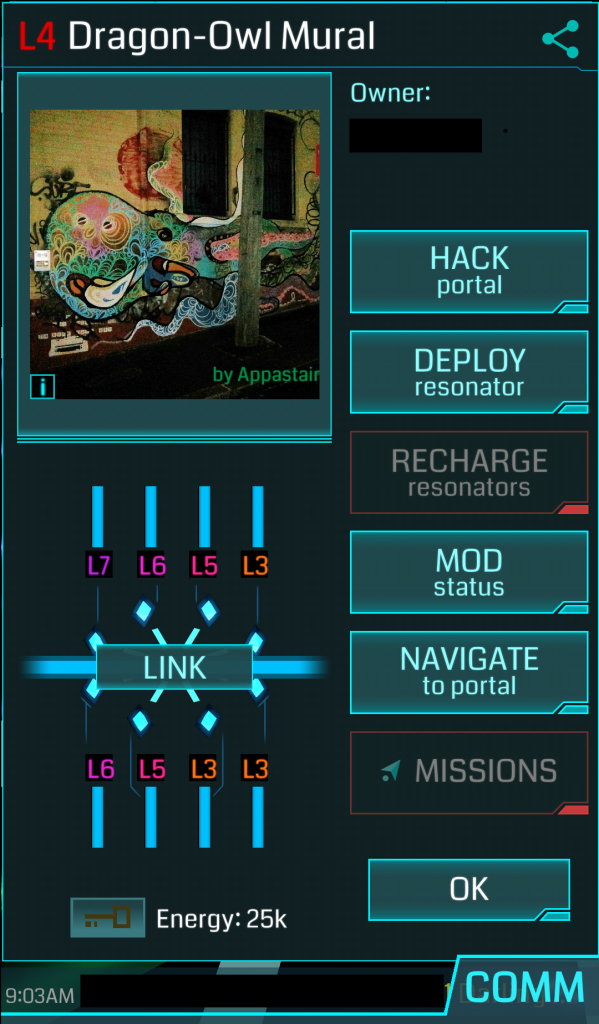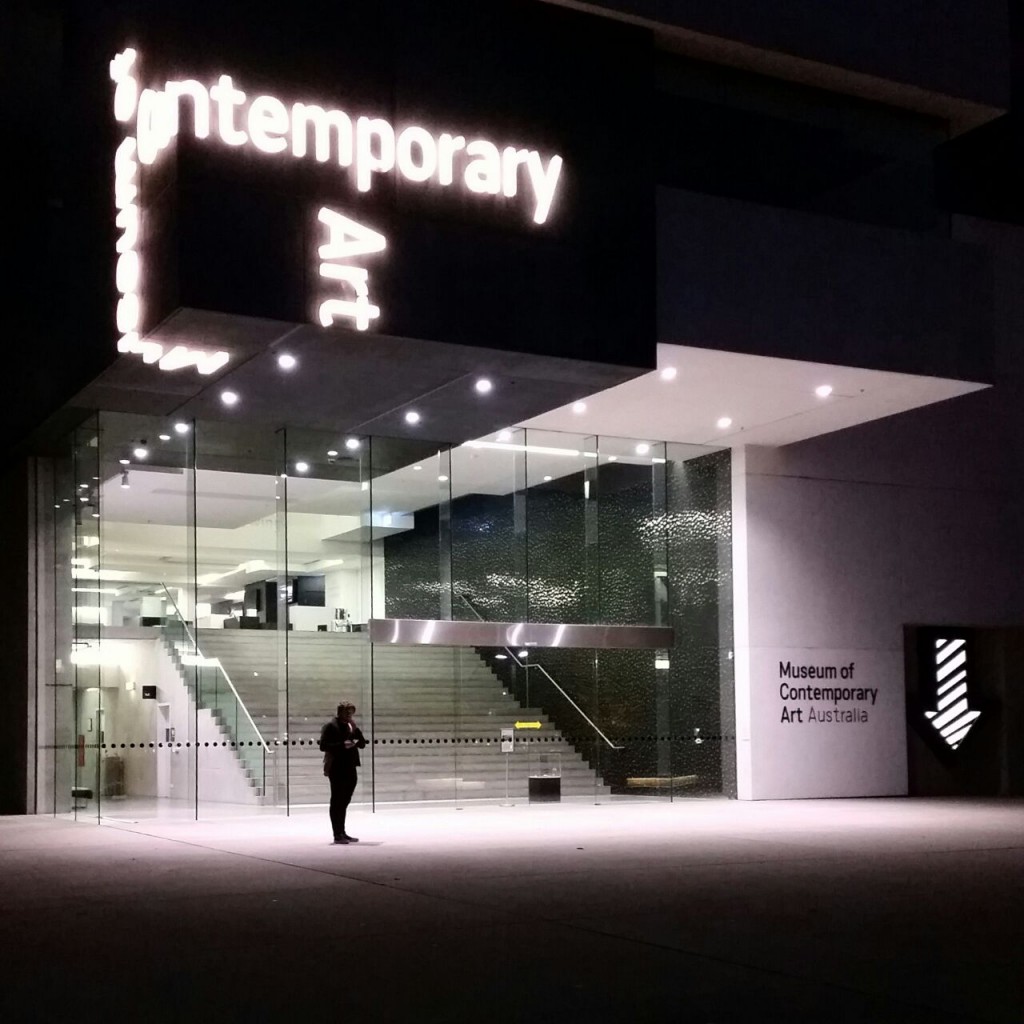“The world around you is not what it seems,” lures the tagline for popular alternate-reality mobile game Ingress, which repurposes public landmarks into contested territory in a battle between two rival in-game factions.1 Released in 2012 as an open-beta for Android devices, Ingress has now been downloaded 12 million times across both Android and Apple devices.2 The game was developed by Niantic Labs, a former subsidiary of Google, and tasks players with territorializing their material environment through interaction with the mobile-based application. Using their mobile devices, players are equipped with a map of “portals”—user-submitted locations in the real world—and gameplay consists of engaging, capturing, and connecting these portals in order to control territory. Portals exist not only as nodes within a digital representation of the material space, but also as physical landmarks that bear sociocultural and material significance prior to their incorporation into the game.3 I argue that within this type of mobile-mediated urban gaming, play is shaped by the player’s localized knowledge—how players learn to live within and move through space—as well as a sociocultural knowledge—social and cultural notions of what constitutes play within urban spaces. By focusing on portals as in-game elements with out-of-game materiality, this paper explores how players’ individual knowledge of the urban environment informs larger cultural notions of what constitutes play.
This paper suggests that, through portals, players are engaging in the practice of urban play. I adapt the term “urban play” from digital media scholars Adriana de Souza e Silva and Larissa Hjorth’s work on historically situated forms of urban playfulness.4 I use the term to refer to a broad category of activities that utilize the material structures of the urban environment in a playful manner. Such practices demonstrate a literacy of the urban environment while also blurring the boundaries between functional urban mobility and playful exploration, thus allowing for a re-reading of the urban environment as a space in which to enact new, often subversive, forms of play. When playing Ingress, players perform prior local knowledge through their everyday practices of urban mobility, an articulation of understanding the urban environment as a series of navigable routes and material objects. But through the process of gameplay, this everyday urban mobility—from wandering back streets to taking public transport—becomes tied up in the practice of play, thus re-shaping our understanding of the urban environment from a functionally navigable space into a series of potentially playable objects. For example, mundane forms of urban mobility, such as daily commutes to and from work, are transformed into playful practices by playing Ingress. I argue that by focusing on the use and expansion of local material knowledge,5 we are able to challenge sociocultural notions of what constitutes play within urban environments. This paper firstly focuses on the role the material environment has in facilitating a player’s knowledge of the urban environment, such as the role of historical landmarks and understanding patterns of navigation and transportation. I assert that these forms of localized knowledge form the primary basis of and situate the act of play within the urban environment. Secondly, this paper focuses on how “urban play” is a sociocultural construct that builds upon the player’s understanding of the urban environment and the ways in which play challenges the social, material, and cultural conditions that frame the urban environment as a functional space. Finally, I conclude by tying both perspectives together in order to show how Ingress loosens the rigidity of material environments and transforms them into fluid, subversive spaces of play.
Entering Ingress: The Backstory
Ingress has a complex narrative that underscores the practice of playing within material environments. The lore of the game states that in 2012, working alongside research into the Higgs boson at CERN in Geneva, Switzerland, a substance known as Exotic Matter (or XM) was discovered. Exotic Matter is believed to be associated with an unknown group of entities known as “Shapers”. In-game factions are divided based on their association with Shapers. The Enlightened (Green) wish to aid the Shapers’ infiltration of Earth, in the hopes of instigating an enlightenment. The Resistance (Blue), unsurprisingly, work towards defending humankind from any form of infiltration. The primary goal of the game is to form “control fields” through the linking of portals. Portals are located at public landmarks, and are surrounded on the game map by eight “resonators”—deployable in-game objects used to capture or upgrade portals. Game-play entails tapping portals on the map to open a list of possible actions and portal information. Alternatively, players can hold down on a portal via the in-game map (scanner) to quickly engage with it. Players “hack” portals using these modes of interaction, which give players the materials to either attack or deploy resonators. By linking three nearby portals, players can form a control field, which strengthens a faction’s control over that particular location by making it harder for the other team to destroy portals and gain dominance over specific locations.
Portals are submitted by players through the game’s interface and subjected to Niantic Lab’s portal review criteria.6. Interestingly, portals are not just present at large or historic landmarks. They have also been established at public murals, unauthorized street art, and a large number of informational displays. By placing portals at landmarks or points of public interest, players are actively drawing on their local knowledge. Additionally, the game’s guiding players to visible public landmarks may strengthen their knowledge of unfamiliar locations and aid them in navigating new environments. By focusing on players’ existing knowledge of urban environments, this paper suggests that urban play is best understood as a situated practice. Situated practice builds on existing sociocultural and material conditions that shape the urban environment and urban mobility. Situated practice is thus an integral attribute of Ingress, in which the game system is open to a range of emergent practices,7 which are often articulations of the player’s specific localized knowledge of the environment coupled with a sociocultural understanding of the urban as a series of functional—or indeed subversive, as with street art—objects. This approach to urban play as a situated practice draws from the field of human-computer interaction and the concept of situated action—or in short, the means in which player’s knowledge expands the system of the game itself.


A Situated Approach to Urban Play
In developing a situated approach to urban play, this paper draws primarily on the vocabulary of Lucy Suchman and Paul Dourish. The term situated is adopted from the work of science and technology scholar Lucy Suchman, who uses the concept of situated action to understand the relationship between humans and technology.8 The concept was developed as a counterpoint to the overarching focus the field of human-computer interaction has had on the material constraints of technology and the desired activities such constraints afford. Suchman asserts that such “planned” activities do not reflect the actual practice of engaging with technology. Rather, planned activities are in fact representations of situated actions, constructed in retrospect to engagement with the given technology. Applying Suchman’s concept to Ingress, the planned activities would be the goals and formalized rules of the game, or even the retrieval of data used to create Google Maps. However, the emergent behavior of players and the material constraints of the urban environment, alongside the unpredictability of the non-playing public, form a set of contextual circumstance which result in unique forms of play (situated actions) that build on the player’s subjective understanding of the urban environment and their lived experience within said environment.
Following from the work of Suchman, computer scientist Paul Dourish provides a detailed discourse analysis of the word “context” as it is used in the field of human-computer interaction. 9 Dourish notes that within this field, the term has dual origins as both a technical notion and one which draws analytic attention to certain aspects of social settings. Dourish suggests we turn attention away from context, as a set of descriptive features of settings, and focus instead on the idea of practice, as the forms of engagement with those settings. Drawing from the concept of situated learning and the work of educational theorist Etienne Wenger,10 Dourish views practice not only as experiencing the world, but also as the means by which engagement is found to be meaningful. Dourish’s use of the concept of practice is one that unites action and meaning, a description of the world revealing itself as meaningful for particular forms of action. Following this view, playing Ingress is not only underscored by the material and sociocultural circumstances of the urban environment, but is also part of an active process of creating new forms of meaning with regards to these circumstance. As such, Ingress not only builds on the player’s local knowledge, but also produces new forms of sociocultural knowledge through the process of re-framing certain actions as “play” rather than as functional urban mobility.
Playing Ingress requires an understanding of localized forms of navigation and what constitutes the urban space. The urban is made up of multiple material elements, which gain meaning through social and cultural interaction. Within the context of Ingress, large public landmarks, street art, informational displays, historical plaques and so forth are no longer only functional as forms of cultural heritage, understood primarily through a shared understanding of a locations past and present. Rather, these objects become potential portals, as users may submit any location for consideration to become an in-game portal. However, because Niantic stipulates that portals must contain historical or educational significance, players must possess a certain knowledge of local environments in order to know what specific objects may become portals. Through portal submissions and subsequent urban play, players of Ingress engage critically with what constitutes the urban by gaining an understanding of material objects and locations and their role within specific urban locations. Popular bus routes, dense urban environments, and locations with historical value or a high number of informational displays all become high traffic areas for playing Ingress. As such, players are able to articulate their engagement with the material environment and demonstrate an accumulation of local knowledge.
Certain locations become territorialized not only by the in-game map itself, but also by a shared understanding of player traffic. For instance, a location often visited by a group of high-ranking Resistance members quickly becomes difficult for Enlightened players to attack and overturn the territory. Through my own play sessions in Sydney, Australia, I observed that certain locations, such as busy transport routes and certain suburbs, would become continuously less contested in nature, becoming permanently constructed territories due a high number of same-faction players moving through these locations, as players utilized their daily commutes and proximity to everyday locations as part of their playing strategy. Here, locations become deeply tied to player and faction identity, with certain suburbs being tied to factions, and certain high level players being tied to these suburbs. While this observation is not meant to denigrate the skill of such players, it is nonetheless important to acknowledge how their embodied knowledge of such locations—that is, their lived interactions and familiarity with these locations—plays an important role in this process of territorial construction. With urban play, therefore, “skill” is less about the embodied and gestural literacy of engaging with input devices or building on existing gaming literacy from similar games or genres, and more about an articulation of a critical engagement with the urban environment, and a demonstration of understanding the urban environment as a series of material objects as well as systems of movement between said objects and locations.

Playing with Portals
For Ingress players, urban knowledge—or lack thereof—is articulated through engagement with portals. Players mediate their material environment and navigational practices through the use of the game’s built-in map system. Within this system, public landmarks or points of public interest are represented as color-coded nodes placed on a large map. Alongside this technological intervention in navigational practices, this engagement is primarily an articulation of embodied knowledge – the accumulation of knowledge through lived experiences and engagements with locations. Players build on their existing knowledge of urban environments gained through everyday engagements with these locations. Such a practice is similar to literacy researcher James Paul Gee’s[15] discussion of playing video games as a form of situated learning whereby players contextualize their knowledge within the game itself.11 For Gee, the practice of learning through play is based on players probing and re-thinking their relationship with the game as a system. Players engage with the game with an initial hypothesis in mind, and in the course of gameplay respond to feedback and re-think any pre-given hypothesis based on the game’s feedback. Such results are often then articulated through larger communities who work to achieve and legitimize a shared understanding of digital gaming systems and interactions with technologies. With forms of urban play such as Ingress, the player’s hypothesis comes in the form of existing knowledge of material environments. By creating portals at minor landmarks such as information panels, or ephemeral landmarks like street art, players are able to expand not only their knowledge of local environments but also add to a shared sociocultural understanding of that location and of what constitutes urban play within these spaces. This results in sociocultural constructions of urban play tied to practices of being in and moving through the city, and of everyday urban mobility and local knowledge as the primarily basis for all forms of playful interaction with urban environments.

Social communication, both within in-game communication channels and out-of-game social networking services, provides a platform for understanding how the material environment shapes the practice of urban play. While many strategies, suggestions, and large-scale in-game actions may be coordinated through social networking platforms, the material environment itself plays an important role in shaping the practice of urban play. The practice of playing within urban environments has been described by de Souza e Silva and Hjorth as simultaneously transformative and inherent.12 Transformative in that the urban environment and the material objects within said space are repurposed, and inherent in that such material objects come with the potential to be played. Such a conceptualization suggests similarities between the urban environment and a game board, where the material affordances of the game space inform and restrict the potential movements of the players. Here, our understanding of play is shaped by the afforded structure of the space: urban play is not only subjected to the encoded rules of the game, but also to the sociocultural construction of what we consider to be appropriate behavior within these public spaces. Increasingly, urban play becomes less about energetic sports like parkour or skateboarding, and more about the intersection between the mobile device, software, and the material environments. Significantly, this results in urban play becoming less conspicuous, as the gestures of players now fail to signal to non-players that play is taking place. This can produce moments of transgressive play, as locations deemed as appropriate for play based on their inclusion in the game’s intel map may be considered inappropriate within their sociocultural contexts. Places of historical or religious value may fit the portal criteria for Ingress, but may fail to take into account the historical specificity or cultural significance of such locations.13
Within the urban environment, as with all play, the activity is in part afforded by the materiality of the environment. As the playground affords certain types of playful activities, so too do the streets of the city. For play scholar Miguel Sicart the metaphor of the playground allows for an exploration of play as a creative activity able to move beyond the design of the material space.14 To view the city as a playground, rather than as a game space, is to view it as potentially open to playful activities. As the Situationist International performed their practice of dérive to subvert the structure of the city through aimless wandering, urban play suggests a type of subversion of urban mobility.15 This tension is generated through the perceived functionality of the city, primarily as a site of commerce. Those who can afford leisure time are able to play with these perceptions, establishing a link between urban play and class. The city itself may be deemed a potentially or inherently playful site, but the question is for whom is that the case? Game designer Mary Flanagan explores further the practice of the dérive through her own vocabulary of wandering and drifting.16 She compares those who wander as a form of artistic expression and subversion of the capitalistic structures of the urban, and those who drift out of obligation due to their social and economic disempowerment. In regards to this, those who play Ingress are articulating their economic and social power, their ability to engage in leisure time and freely wander the urban environment, and the power to subvert, transform, and re-contextualize material objects for the sake of play. With this, the notion of what constitutes urban play becomes deeply tied to who has the ability to play within these spaces, and under what terms.
Similar to that of a board game, players’ engagement with the space may become emergent, dynamic, and unpredictable, and may be subject to a local formulation of rules, similar to the “house rules” common in board games. These are sociocultural negotiations with the player’s material environment and the possibilities afforded to players within the proximate space in which play is conducted. There is, to some extent, a possibility for movement, but only movements that are physically afforded to players by the material environment. Players may submit portals to the game’s admin, but portals require a material anchoring. Similarly, players must perform play within physical proximity of the portal itself. Navigating these material constraints ties directly to existing sets of local knowledge and a desire to further explore urban environments. While the sociocultural aspects to urban play—the how and why we play in cities—is an important element in understanding games such as Ingress, it is possible to argue that the materiality of these play spaces has significant impact on the reasons for and the means by which individuals and groups play. For instance, there is a clear disparity between urban, suburban, and rural Ingress players. The urban, with high density of potential portals and higher flows of potential players passing through these dense areas, results in highly contested in-game territories. Alongside this, transport infrastructure plays an import role in facilitating highly contested zones within urban environments. Those who travel on such routes to and from central urban locations form the basis of a playing elite, whose flexibility in work allows for increased access to technology and potential play time. While knowledge of material environments forms a key basis to play, access to these material infrastructures also plays an important role in facilitating urban play.

Conclusion
Ultimately, Ingress re-purposes objects within the urban environment, objects which feature in players’ everyday embodied local knowledge. Situated between regional bodies of knowledge and the creation of a global networked map of public landmarks, players embody the practice of urban navigation through their engagement with and navigation between key public landmarks. By engaging with portals located at public landmarks, players participate in the situated practice of play. That is, they participate in established sociocultural and material practices common with navigating urban environments, while simultaneously creating new meanings for these locations, such as the strategic importance of certain locations and landmarks. The material environment comes with an embedded narrative, one established by institutional or government regulations of public places and articulated through histories of locations, through tourism, and through lived experiences of communities. Ingress plays with these sociocultural circumstance, as well as the material circumstance that give shape to the material environment as a space of play. Shared understandings of these spaces, either through online or local communities, are then reframed through engagement with portals. The significance of these landmarks, as local historical or cultural significance, is recontextualized and given new significance within the context of Ingress. While playing Ingress may indeed recontextualize this knowledge, the practice of playing is also deeply shaped by material and sociocultural circumstance of local environments. Furthermore, what constitutes play becomes challenged by these material conditions. Everyday forms of urban mobility—navigation, commuting, wandering, and exploring—all become valuable forms of play and allow for a rich and complex playful practices. What is at stake in Ingress is not just a blurring of boundaries between play and non-play, but a more robust understanding of what may be considered play.
–
Featured image by Toshihiro Gamo on Flickr, CC BY-NC-ND.
–
Kyle Moore is a PhD candidate at the University of Sydney from the Department of Media and Communications. His current research explores the ways play is situated within urban environments, focusing on the sociocultural and material circumstance which frame our understanding of play.

